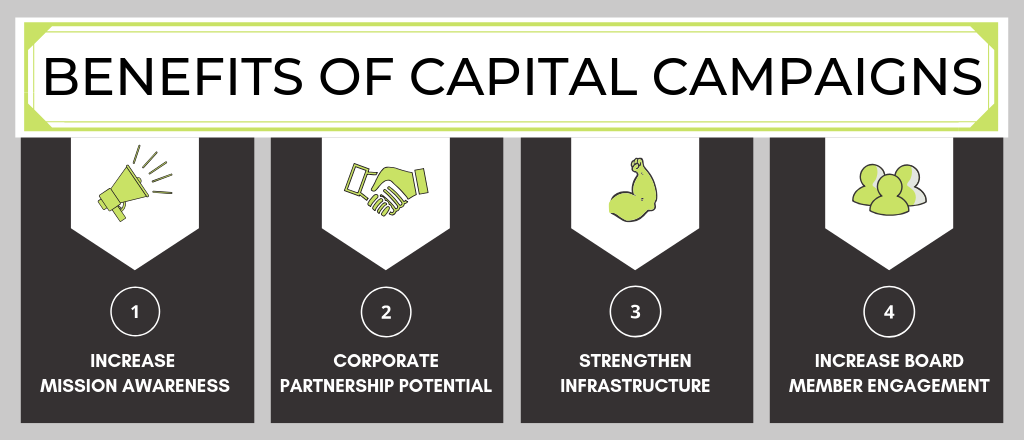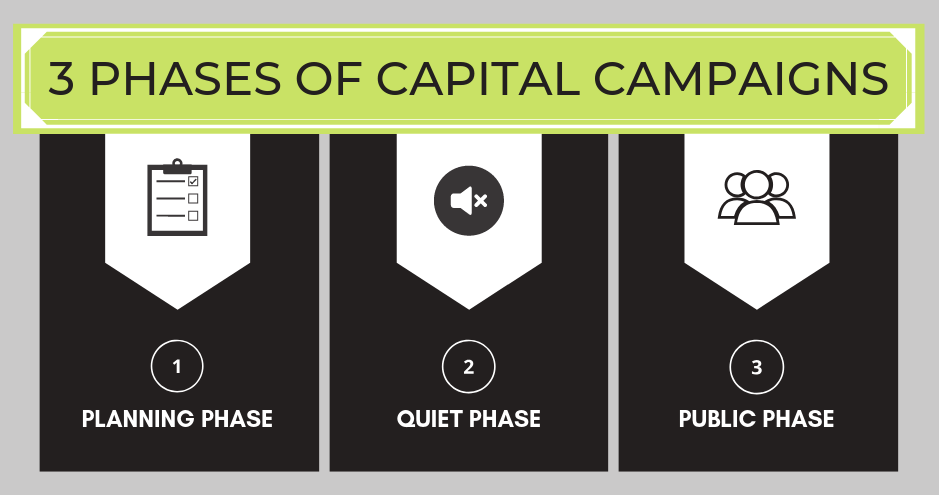Is your organization considering a capital campaign? Whether your nonprofit is preparing for its first capital campaign or there’s a large fundraising project on the horizon, we’re here to give you the information you need to get started!
Here you will learn the benefits and best practices of capital campaigns. We’ve updated this article for 2024, so you’re getting our latest strategies.
What is a Capital Campaign?
Capital campaigns are targeted efforts by nonprofits to raise funds for a specific goal over a defined period of time. These types of efforts are vital to advancing your mission and typically have the goal of raising significant amounts of money. Projects can include the start of an endowment for a new wing at your healthcare institution, a new building, or much-needed land acquisition.
While in the past capital campaigns have been reserved for brick-and-mortar projects, nonprofits from various industries are using capital campaigns to support a variety of projects. Capital campaigns permit the organization to serve more people and have a greater impact on the community. Many campaigns combine annual funds, major gifts, special project solicitations, and planned giving programs to raise funds for research projects, scholarships, staff continuing education, professorships, community outreach programs, and building endowments. Simply put, capital campaigns can offer nonprofits the resources they need to achieve better results than ever before.
Beyond the obvious financial benefits, there are even more advantages to running a capital campaign at your organization.
Benefits to Capital Campaigns

- Increase Awareness – Launching a large capital campaign to further the aims of your organization is a great way to boost awareness of your organization’s mission.
- Corporate Partnership Potential – There are unlimited opportunities available from the business connections you make during a capital campaign. Corporate partners are great prospects for major gifts. Major gifts can inspire further engagement via those corporate partnerships. Many corporations earmark money in the budget to go towards corporate social responsibility initiatives.
- Strengthen Your Organization – Capital campaigns require an intense amount of time, effort, and coordination, as well as transparency, from your organization. It is important for nonprofits to have the proper infrastructure in place to support campaign efforts. Capital campaigns can help your organization assess its institutional capacity (their needs and development areas).
- Better Your Board Engagement – Board members not only make thoughtful gifts but are necessary community ambassadors for your capital campaign. During your campaign, they can become re-energized and better motivated to serve. Inspiring one major gift donor often motivates similar support from others.
3 Phases of Capital Campaigns
That being said, it is important for organizations to dedicate time and resources to developing a plan to ensure a successful capital campaign. When developing your plan, consider the three phases of capital campaigns: the planning phase, the quiet phase, and the public phase.

Planning Phase – Due to the large fundraising goals and length of time it takes to raise this type of money, ensure your team has a well-thought-out, actionable plan.
- Hire a consultant – Because capital campaigns are such a massive undertaking for an organization, they can cause real disruption to the daily operations of your nonprofit. Nonprofits can get help from a capital campaign consulting firm to assist. Consultants can provide guidance and direction on how to plan your capital campaign.
- Conduct a feasibility study – Through the use of surveys, nonprofits use feasibility studies to gauge whether or not they’ll be able to meet the goals they hope to accomplish with a potential capital campaign. Conduct interviews of 20-50 members of your community and board to evaluate their interest in participating in your capital campaign. Communicate to them your fundraising goal and the different giving levels you’ve identified, and keep them aware of any fundraising events you plan to host.
- Conduct prospect research – Develop a process of identifying promising leads for solicitation. During a capital campaign, your research should focus on donors with a high giving capacity to help reach your campaign goal. It’s essential to identify multiple prospects for donation who you’ll need to approach at different levels of giving.
Quiet Phase – During the quiet phase, nonprofits aim to raise 50-70% of their fundraising goal through major gift acquisition.
- Develop a compelling case for support – Constructing a compelling case statement for your capital campaign is crucial to donor solicitation. The concise statement details: what the campaign is for, the aim of raising the capital, and organizational successes and aims. Include your statement in your capital campaign brochures to leave with major gift prospects so that your campaign stays with them.
- Solicit prospects in unique ways – Major donors, individuals, and corporations receive many proposals. Make sure that yours stands out in a personal way.
Public Phase – Once the capital campaign goes public, the remaining fundraising goal is met by soliciting smaller gifts from a large pool of donors.
- Launch a kickoff event – This is an integral part of launching your campaign’s public phase. A successful kickoff event generates public excitement and gets the public phase off to the right start. Ensure your organization highlights its successes during the quiet phase to demonstrate the likelihood of overall campaign success.
- Social fundraising – Utilize new social fundraising technology to effectively handle the donation of small gifts. Social fundraising is a great way to leverage the networks of your existing supporters to your advantage.
With crowdfunding and peer-to-peer fundraising, nonprofits enable supporters to create pages that specifically raise money for your capital campaign. Donors and supporters are able to share this page across social media platforms to encourage their friends to give. You’re also expanding your donor base as your supporters share their campaign page to get the word out.
Capital Campaign Fundraising in Uncertain Times
Of course, you can plan everything right, and then external factors such as a shift in the economy or a natural disaster might not produce the ideal environment to raise funds. We’ve experienced uncertain times throughout history, and we still manage to preserver.
When it comes to fundraising during challenging times, it’s common to feel anxious about the future or worried that your donors will stop giving or give less. However, it is important to stay calm and move the campaign forward.
Two key pieces of advice:
- Stay in touch with your donors. Now is the time to not only maintain but actually work towards strengthening your relationship with donors. Different people also react to challenging times differently. Some donors may scale back due to their own financial situation; while others may opt to give more because others are in crisis. Continue to share how your organization is serving your mission and supporting your community during challenging times. If you are having to make changes to the way you serve your community, share that story. Your donors may applaud your efforts and step up to help out.
- Continue your campaign. Keep in mind that you are holding a capital campaign to raise funds for something that is vital to your organization. Now is not the time to end efforts. Instead, continue to share with your donors why this campaign is important to your cause, the progress you’ve made so far, and what you will be able to do once you achieve your goal. By sharing updates and keeping the campaign top of mind, donors may be even more inclined to contribute to ensure that the campaign achieves its goal. Be sure to also celebrate your donors’ generosity and sympathize when they have to cut back on their philanthropy for the time being. If you focus on building your relationships with your donors, they will support you in the long run!
Key Takeaway
If you’re considering a capital campaign, be sure to have your plan in place including the right technology to support your goal.
Schedule a complimentary tech strategy session to discuss your campaign and organization goals with one of our experts. We’ll help you determine how Giveffect can help you execute your plan and track your results.